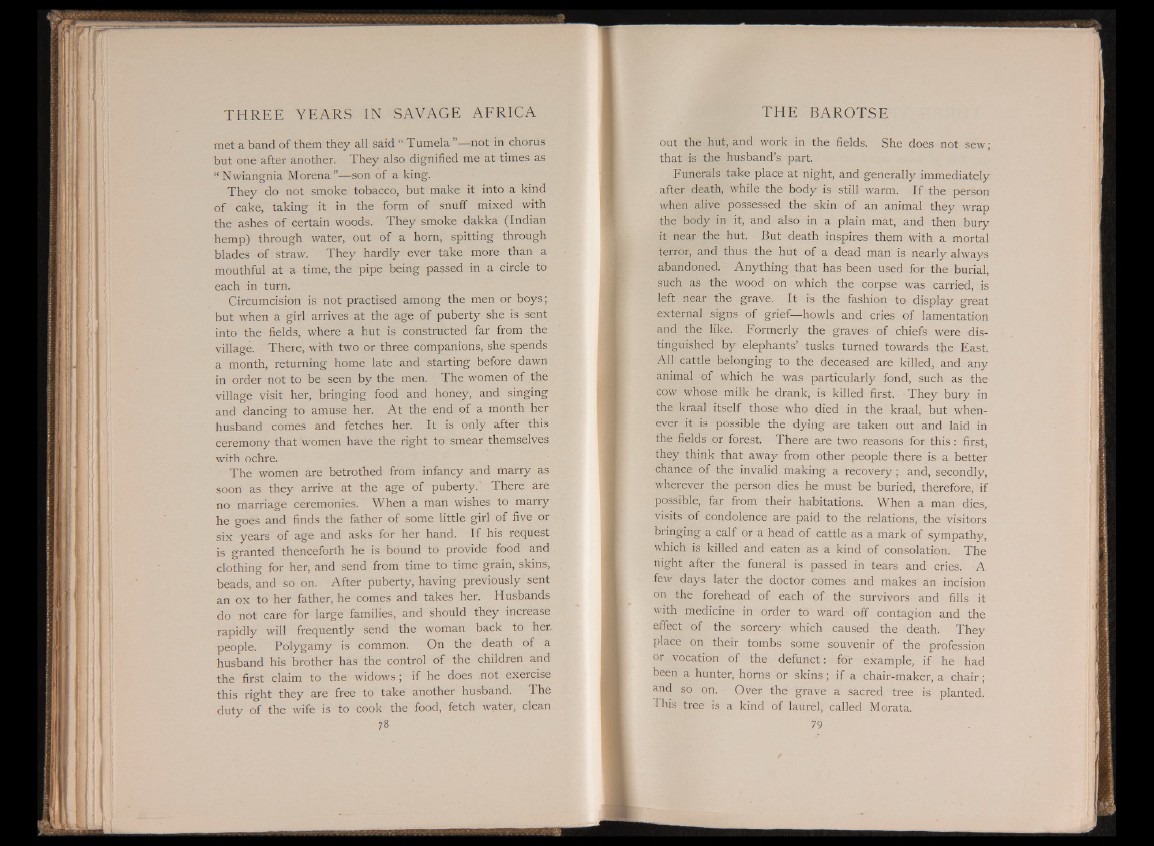
met a band of them they all said “ Tumela ”||-not in chorus
but one after another. They also dignified me at times as
“ Nwiangnia Morena”—son of a king.
They do not smoke tobacco, but make it into a kind
of cake, taking it in the form of snuff mixed with
the ashes of certain woods. They smoke dakka (Indian
hemp) through water, out of a horn, spitting through
blades of straw. They hardly ever take more than a
mouthful at a time, the pipe being passed in a circle to
each in turn.
Circumcision is not practised among the men or boys;
but when a girl arrives at the age of puberty she is sent
into the fields, where a hut is constructed far from the
village. There, with two or three companions, she spends
a month, returning home late and starting before dawn
in order not to be seen by the men. The women of the
village visit her, bringing food and honey, and singing
and dancing to amuse her. At the end of a month her
husband comes and fetches her. It is only after this
ceremony that women have the right to smear themselves
with ochre.
The women are betrothed from infancy and marry as
soon as they arrive at the age of puberty.' There are
no marriage ceremonies. When a man wishes to marry
he goes and finds the father of some little girl of five or
six years of age and asks for her hand. If his request
is granted thenceforth he is bound to provide food and
clothing for her, and send from time to time grain, skins,
beads, and so on. After puberty, having previously sent
an ox to her father, he comes and takes her. Husbands
do not care for large families, and should they increase
rapidly will frequently send the woman back to her.
people. Polygamy is common. On the death of a
husband his brother has the control of the children and
the first claim to the widows; if he does not exercise
this right they are free to take another husband. The
duty of the wife is to cook the food, fetch water, clean
78
out the hut, and work in the fields. She does not sew;
that is the husband’s part.
Funerals take place at night, and generally immediately
after death, while the body is still warm. If the person
when alive possessed the skin of an animal they wrap
the body in it, and also in a plain mat, and then bury
it near the hut. But death inspires them with a mortal
terror, and thus the hut of a dead man is nearly always
abandoned. Anything that has been used for the burial,
such as the wood on which the corpse was carried, is
left near the grave. It is the fashion to display great
external signs of grief—howls and cries of lamentation
and the like. Formerly the graves of chiefs were distinguished
by elephants’ tusks turned towards the East,
All cattle belonging to the deceased are killed, and any
animal of which he was particularly fond, such as the
cow whose milk he drank, is killed first. They bury in
the kraal itself those who died in the kraal, but whenever
it is possible the dying are taken out and laid in
the fields or forest. There are two reasons for this: first,
they think that away from other people there is a better
chance of the invalid making a recovery; and, secondly,
wherever the person dies he must be buried, therefore, if
possible, far from their habitations. When a man dies,
visits of condolence are paid to the relations, the visitors
bringing a calf or a head of cattle as a mark of sympathy,
which is killed and eaten as a kind of consolation. The
night after the funeral is passed in tears and cries. A
few days later the doctor comes and makes an incision
on the forehead of each of the survivors and fills it
with medicine in order to ward off contagion and the
effect of the sorcery which caused the death. They
place on their tombs some souvenir of the profession
or vocation of the defunct: for example, if he had
been a hunter, horns or skins; if a chair-maker, a chair;
and so on. Over the grave a sacred tree is planted.
This tree is a kind of laurel, called Morata.